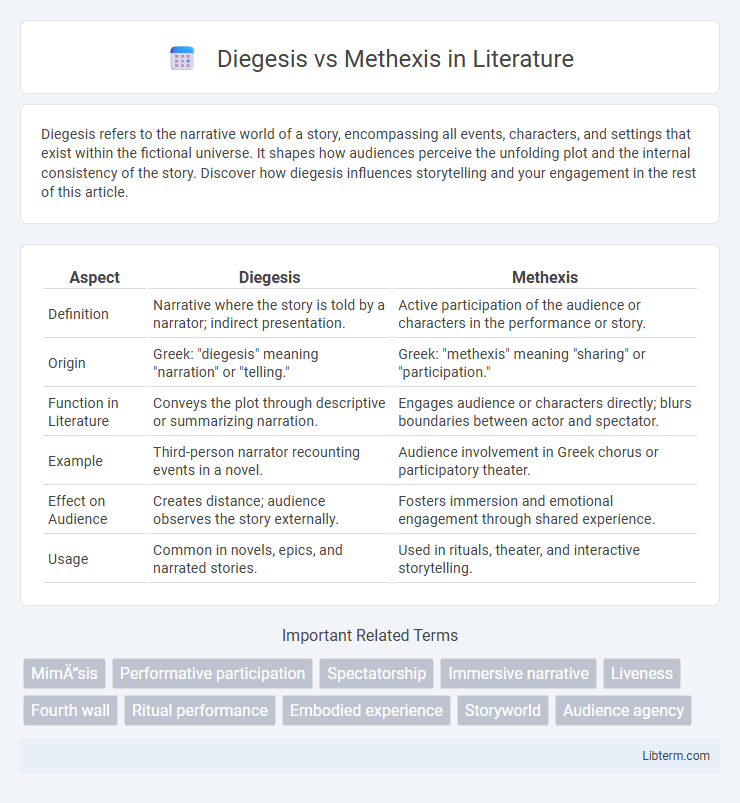Diegesis refers to the narrative world of a story, encompassing all events, characters, and settings that exist within the fictional universe. It shapes how audiences perceive the unfolding plot and the internal consistency of the story. Discover how diegesis influences storytelling and your engagement in the rest of this article.
Table of Comparison
| Aspect | Diegesis | Methexis |
|---|---|---|
| Definition | Narrative where the story is told by a narrator; indirect presentation. | Active participation of the audience or characters in the performance or story. |
| Origin | Greek: "diegesis" meaning "narration" or "telling." | Greek: "methexis" meaning "sharing" or "participation." |
| Function in Literature | Conveys the plot through descriptive or summarizing narration. | Engages audience or characters directly; blurs boundaries between actor and spectator. |
| Example | Third-person narrator recounting events in a novel. | Audience involvement in Greek chorus or participatory theater. |
| Effect on Audience | Creates distance; audience observes the story externally. | Fosters immersion and emotional engagement through shared experience. |
| Usage | Common in novels, epics, and narrated stories. | Used in rituals, theater, and interactive storytelling. |
Introduction to Diegesis and Methexis
Diegesis refers to the narrative technique where the story is told by a narrator, presenting events from within the fictional world, often encompassing characters' thoughts and background details. Methexis, in contrast, involves audience participation and shared experiences, emphasizing communal involvement rather than a detached narrative voice. Understanding the distinction between diegesis and methexis is crucial for analyzing storytelling methods in literature, theater, and film.
Defining Diegesis: Origins and Applications
Diegesis, originating from the Greek term "diegesis," refers to the narrative world in which events, characters, and settings exist within a story's internal reality. It encompasses all elements that are directly experienced by characters, shaping the immersive framework of literature, film, and theater. Applications of diegesis extend to distinguishing between narrative storytelling techniques and audience perception, critical for analyzing fictional environments and media narratives.
Understanding Methexis: Meaning and Context
Methexis refers to the concept of shared participation or collective experience, often used in theatre and performance studies to describe the audience's active involvement in the narrative or ritual. Unlike diegesis, which involves a narrated or told story, methexis emphasizes immersive engagement where the boundary between performers and audience blurs. This participatory dynamic fosters a deeper emotional and communal connection, highlighting the social and cultural context of the event.
Historical Evolution of Diegesis and Methexis
Diegesis, originating from ancient Greek narrative traditions, evolved as a storytelling technique emphasizing the narrator's voice to convey events within a fictional world, prominently seen in classical literature and early drama. Methexis, rooted in Greek theatre, particularly in the works of Aristotle, refers to audience participation or communal sharing in the performance, highlighting the immersive nature of ancient rituals and tragedies. Over time, diegesis and methexis diverged in their applications, with diegesis dominating literary and cinematic narration, while methexis influenced interactive and performative art forms, reflecting their distinct historical trajectories in narrative theory.
Diegesis in Literature, Theatre, and Film
Diegesis in literature, theatre, and film refers to the narrative world where characters, events, and objects exist within the story's universe, encompassing all elements that belong to the plot's reality. In literature, diegesis involves the narrator describing actions and events, guiding the reader through the story's internal world. Theatre and film utilize diegetic elements such as dialogue, sound, and setting to immerse audiences in a cohesive fictional environment that supports narrative coherence and character development.
The Role of Methexis in Performance Arts
Methexis in performance arts involves active audience participation and a shared experience between performers and spectators, blurring the line between observer and actor. This collaborative engagement fosters communal meaning-making, enhancing the theatrical event's emotional and cultural impact. Unlike diegesis, which presents a narrated story, methexis transforms performances into dynamic, interactive rituals that emphasize collective presence and co-creation.
Key Differences Between Diegesis and Methexis
Diegesis involves the narration or telling of a story, where the audience receives information through a narrator or character, creating a primarily descriptive experience. Methexis represents the direct participation of the audience or actors within the story, emphasizing shared experience and immersion rather than distant observation. The key difference lies in diegesis's reliance on narration versus methexis's focus on communal engagement and enacted presence in the narrative.
Comparative Analysis: Audience Engagement
Diegesis involves a narrative-driven engagement where the audience absorbs the story through characters and plot, fostering a deep emotional connection. Methexis emphasizes participatory involvement, encouraging the audience to actively co-create or influence the unfolding experience, enhancing interactivity and immersion. Comparing both, diegetic methods promote empathy and understanding via storytelling, while methectic approaches generate dynamic engagement by breaking conventional narrative boundaries.
Diegesis vs Methexis in Modern Storytelling
Diegesis in modern storytelling involves the narrator directly conveying the story's events and characters, shaping the audience's interpretation through descriptive and explanatory narration. Methexis emphasizes audience participation, inviting viewers or readers to actively engage and co-create the narrative experience, fostering a communal or immersive interaction. The contrast between diegesis and methexis highlights differing approaches to storytelling: one prioritizing controlled, author-driven exposition and the other promoting interactive, shared meaning-making.
Conclusion: Integrating Diegesis and Methexis
Integrating diegesis and methexis enhances narrative engagement by combining storytelling with audience participation, creating a dynamic interplay between narrator-driven exposition and collective embodiment. This fusion fosters deeper immersion and emotional resonance, as diegetic elements provide context while methexis invites experiential involvement. Effective narrative frameworks leverage both concepts to balance interpretive distance and communal presence, optimizing cultural and theatrical impact.
Diegesis Infographic

 libterm.com
libterm.com